Diana Karenne (1888-1940) was one of the divas of the silent Italian cinema. Between 1916 and 1920, Karenne fascinated European audiences with her eccentric dresses and make-up, and with her primadonna behaviour.
![Diana Karenne]()
Italian postcard by Photo Vettori, Bologna.
![Diana Karenne]()
Italian postcard by Ed. A. Traldi, Milano, no. 448.
![Diana Karenne]()
Italian postcard by Fotocelere.
Gypsy Passion
Diana Karenne was born as Leucadia Konstantia in former Prussia, either in Danzig (now Gdansk, Poland) or Szczeczin. In 1915 she landed in Turin and got acquainted with producer Ernesto Maria Pasquali. He launched her in Passione tzigana/Gypsy Passion (Umberto Paradisi, 1916). Immediately she became a star. Between 1916 and 1922 she starred in many successful films.
![Diana Karenne]()
Italian postcard. Vettori, Bologna, no. 551.
![Diana Karenne in Il romanzo di Maud]()
Italian postcard by Film Soc. An. Ambrosio, Torino. "Maud, don't play with my passion", her lover Giuliano implores her in Il romanzo di Maud (1917).
![Diana Karenne in Il romanzo di Maud]()
Italian postcard by Film Soc. An. Ambrosio, Torino. "One step further and I throw myself from the window", Maud (Diana Karenne) says in Il romanzo di Maud (1917).
Maud, don't play with my passion
Quite soon, Diana Karenne managed to write and direct her own films, and she even designed her own film posters. An example was Il romanzo di Maud/Maud's Romance (1917). It was the second film Karenne directed herself, after Lea (1916). She also played the lead. The film, based on Les demi-vierges (1895) by Marcel Prévost, tells the tale of the free-spirited Maud de Vouvres. Maud's lover is an opportunistic and dubious gentleman, Giuliano di Suberceaux. Their relationship has an impasse, and Maud sees new perspectives in Massimo, a provincial enamored with her. Giuliano doesn't give up and forces her to see him in secret. When Maud en Massimo are married, Giuliano tells poor Massimo the truth, but Maud denies all and chases him away. When Giuliano menaces to kill himself, she coldly responds that she doesn't care. When Massimo forces her to tell, Maud admits her former love but states Massimo is now her only love. Massimo, though, abandons her, inable to forgive her. The film was heavily censored in Italy. After its first release, it always circulated as Les demi-vierges, in particular abroad.
![Diana Karenne in Histoire d'un Pierrot]()
Italian postcard by G.B. Falci, Milano. Photo: still of Diana Karenne in Pierrot/Histoire d'un Pierrot (1917).
![Diana Karenne]()
Italian postcard for Pierrot/Histoire d'un Pierrot(1917).
Pierrot
Another film Diana Karenne directed herself was Pierrot/Histoire d'un Pierrot (1917). She also continued to play in films by other directors such as (Redenzione (Carmine Gallone, 1919), Zoya (Giulio Antamoro, 1920), Miss Dorothy (Giulio Antamoro, 1920), and Smarrita (Giulio Antamoro, 1921). Inspired by Asta Nielsen, Karenne played women who opposed society. Critics didn't accept her transgressive characters but audiences flocked to see her films. Between 1916 and 1920 Karenne fascinated audiences with her eccentric dresses and make-up, and her primadonna behaviour.
![Diana Karenne in Zoya]()
Italian postcard by Vettori, Bologna. Photo: Diana Karenne in the Italian silent film Zoya or Zoja (Giulio Antamoro, 1920), a Tiber Film production. The man left might be Mario Parpagnoli.
![Diana Karenne & Ivan Mozzhukhin in Casanova]()
German postcard by Ross Verlag, no. 83/2. Photo: Ufa. Publicity still of Diana Karenne&Ivan Mozzhukhin in Casanova (1927) by Alexandre Volkoff. This scene was shot near the Venice cemetery Isola di San Michele.
![Diana Karenne in Casanova]()
Austrian postcard by Iris Verlag, no. 928. Photo: Société des Cineromans / Micheluzzi-Verleih / Cine Alliance Film.
Casanova's Major Lover
When things went bad for the Italian film industry, Diana Karenne moved to Paris and later to Berlin. There she had major roles such as the title role in Marie Antoinette (Rudolf Meinert, 1922), and as one of Casanova's major lovers in the visually splendid Casanova (Alexandre Volkoff, 1926) starring Ivan Mozzhukhin. Other directors of her films were Robert Wiene (Das Spiel mit dem Feuer/Playing With Fire (1921)), Richard Oswald (Die Frau von vierzig Jahren/A Forty Years Old Woman (1925)), Yakov Protazananov (L'ombre de péché/The Shadow of Sin (1923)), and Gaston Ravel (Le collier de la reine/The Queen's Necklace (1929)). When sound film arrived, Diana Karenne retired from the film business. She withdrew with her husband to the German city of Aachen, only reappearing once in a bit part in Manon Lescaut (1940, Carmine Gallone), an Italian production derived from the work of Abbé Prévost, starring Alida Valli and Vittorio de Sica. Karenne was also a painter, musician and poet. In July 1940 she was heavily injured by allied bombing of Aachen and she remained in coma for 3 months, never regaining consciousness. Diana Karenne died in October 1940.
![Diana Karenne]()
German Postcard by Ross Verlag, Berlin, no. 531/1, 1919-1924. Photo: Alex Binder.
![Diana Karenne]()
German Postcard by Ross Verlag, Berlin, no. 531/2, 1919-1924. Photo: Alex Binder.
![Diana Karenne]()
German Postcard by Ross Verlag, Berlin, no. 531/3, 1919-1924. Photo: Alex Binder.
Sources: Marlène Pilaete (CinéArtistes.Com), Vittorio Martinelli, (Le dive del silenzio), Vittorio Martinelli (Il cinema muto italiano, 1917), Wikipedia (German), and IMDb.
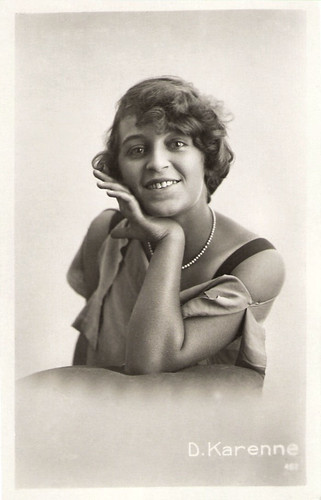
Italian postcard by Photo Vettori, Bologna.
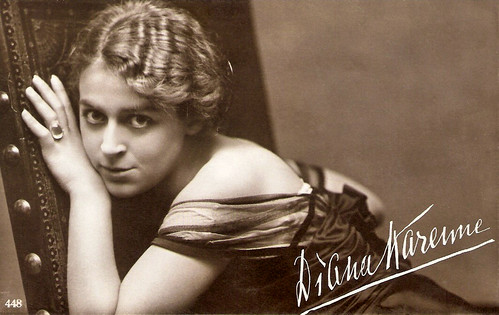
Italian postcard by Ed. A. Traldi, Milano, no. 448.

Italian postcard by Fotocelere.
Gypsy Passion
Diana Karenne was born as Leucadia Konstantia in former Prussia, either in Danzig (now Gdansk, Poland) or Szczeczin. In 1915 she landed in Turin and got acquainted with producer Ernesto Maria Pasquali. He launched her in Passione tzigana/Gypsy Passion (Umberto Paradisi, 1916). Immediately she became a star. Between 1916 and 1922 she starred in many successful films.

Italian postcard. Vettori, Bologna, no. 551.
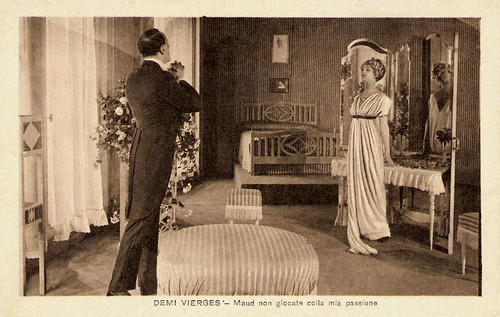
Italian postcard by Film Soc. An. Ambrosio, Torino. "Maud, don't play with my passion", her lover Giuliano implores her in Il romanzo di Maud (1917).
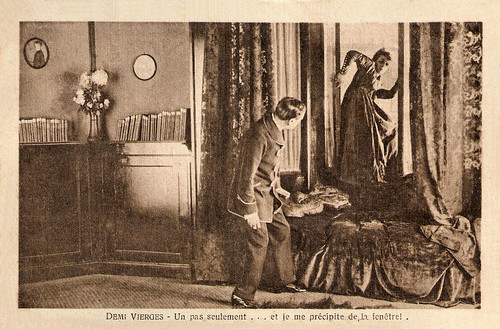
Italian postcard by Film Soc. An. Ambrosio, Torino. "One step further and I throw myself from the window", Maud (Diana Karenne) says in Il romanzo di Maud (1917).
Maud, don't play with my passion
Quite soon, Diana Karenne managed to write and direct her own films, and she even designed her own film posters. An example was Il romanzo di Maud/Maud's Romance (1917). It was the second film Karenne directed herself, after Lea (1916). She also played the lead. The film, based on Les demi-vierges (1895) by Marcel Prévost, tells the tale of the free-spirited Maud de Vouvres. Maud's lover is an opportunistic and dubious gentleman, Giuliano di Suberceaux. Their relationship has an impasse, and Maud sees new perspectives in Massimo, a provincial enamored with her. Giuliano doesn't give up and forces her to see him in secret. When Maud en Massimo are married, Giuliano tells poor Massimo the truth, but Maud denies all and chases him away. When Giuliano menaces to kill himself, she coldly responds that she doesn't care. When Massimo forces her to tell, Maud admits her former love but states Massimo is now her only love. Massimo, though, abandons her, inable to forgive her. The film was heavily censored in Italy. After its first release, it always circulated as Les demi-vierges, in particular abroad.

Italian postcard by G.B. Falci, Milano. Photo: still of Diana Karenne in Pierrot/Histoire d'un Pierrot (1917).
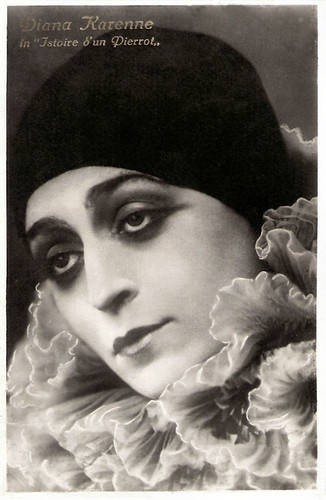
Italian postcard for Pierrot/Histoire d'un Pierrot(1917).
Pierrot
Another film Diana Karenne directed herself was Pierrot/Histoire d'un Pierrot (1917). She also continued to play in films by other directors such as (Redenzione (Carmine Gallone, 1919), Zoya (Giulio Antamoro, 1920), Miss Dorothy (Giulio Antamoro, 1920), and Smarrita (Giulio Antamoro, 1921). Inspired by Asta Nielsen, Karenne played women who opposed society. Critics didn't accept her transgressive characters but audiences flocked to see her films. Between 1916 and 1920 Karenne fascinated audiences with her eccentric dresses and make-up, and her primadonna behaviour.

Italian postcard by Vettori, Bologna. Photo: Diana Karenne in the Italian silent film Zoya or Zoja (Giulio Antamoro, 1920), a Tiber Film production. The man left might be Mario Parpagnoli.

German postcard by Ross Verlag, no. 83/2. Photo: Ufa. Publicity still of Diana Karenne&Ivan Mozzhukhin in Casanova (1927) by Alexandre Volkoff. This scene was shot near the Venice cemetery Isola di San Michele.

Austrian postcard by Iris Verlag, no. 928. Photo: Société des Cineromans / Micheluzzi-Verleih / Cine Alliance Film.
Casanova's Major Lover
When things went bad for the Italian film industry, Diana Karenne moved to Paris and later to Berlin. There she had major roles such as the title role in Marie Antoinette (Rudolf Meinert, 1922), and as one of Casanova's major lovers in the visually splendid Casanova (Alexandre Volkoff, 1926) starring Ivan Mozzhukhin. Other directors of her films were Robert Wiene (Das Spiel mit dem Feuer/Playing With Fire (1921)), Richard Oswald (Die Frau von vierzig Jahren/A Forty Years Old Woman (1925)), Yakov Protazananov (L'ombre de péché/The Shadow of Sin (1923)), and Gaston Ravel (Le collier de la reine/The Queen's Necklace (1929)). When sound film arrived, Diana Karenne retired from the film business. She withdrew with her husband to the German city of Aachen, only reappearing once in a bit part in Manon Lescaut (1940, Carmine Gallone), an Italian production derived from the work of Abbé Prévost, starring Alida Valli and Vittorio de Sica. Karenne was also a painter, musician and poet. In July 1940 she was heavily injured by allied bombing of Aachen and she remained in coma for 3 months, never regaining consciousness. Diana Karenne died in October 1940.

German Postcard by Ross Verlag, Berlin, no. 531/1, 1919-1924. Photo: Alex Binder.

German Postcard by Ross Verlag, Berlin, no. 531/2, 1919-1924. Photo: Alex Binder.

German Postcard by Ross Verlag, Berlin, no. 531/3, 1919-1924. Photo: Alex Binder.
Sources: Marlène Pilaete (CinéArtistes.Com), Vittorio Martinelli, (Le dive del silenzio), Vittorio Martinelli (Il cinema muto italiano, 1917), Wikipedia (German), and IMDb.